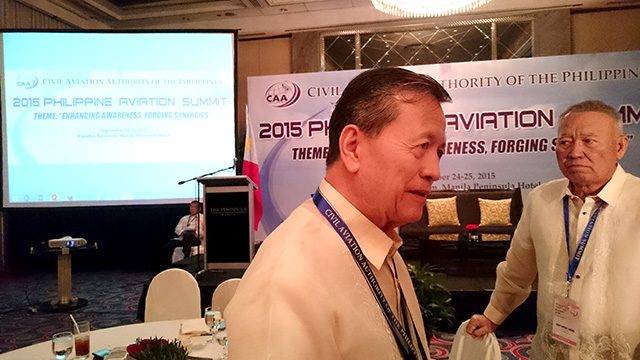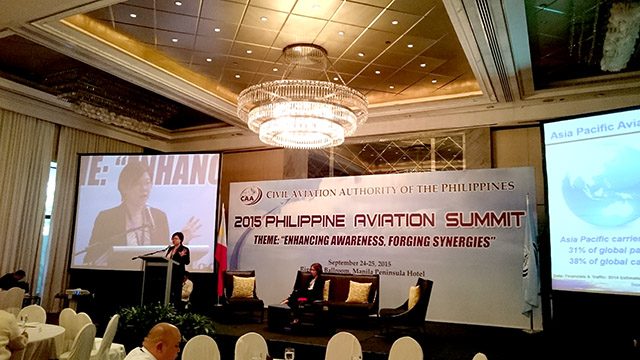SUMMARY
This is AI generated summarization, which may have errors. For context, always refer to the full article.

MANILA, Philippines – As full ASEAN integration approaches this year, streamlining aviation safety regulations across member states is essential for the future of its airlines.
The Philippines is doing its part to help the industry by developing the Civil Aviation Authority of the Philippines (CAAP) Flight Plan 2020, said its director general William Hotchkiss III on the sidelines of the 2015 Philippine Aviation Summit on Thursday, September 24.
“We’re fleshing out the program now. We have a 10-point plan that will help us attain sustainability up to 2020. We’ve already received an aviation upgrade to Category 1 from the US Federal Aviation Administration – if we don’t we’ll slide back to Category 2,” he said.
The plan would give the Philippines a “better playing field, as it would ensure that the country would be constantly adhering to global safety standards,” he said.
CAAP is also working to encourage other Association of Southeast Asian (ASEAN) countries to work together to create a “level playing field” for their individual airlines.
“Regulatory structures need to be the same. For example, if I sign a certificate of air worthiness of a Philippine airplane, then it should be accepted in Burma, and if my counterpart does the same for a Burmese airplane, then it would be accepted here,” Hotchkiss explained.
Addressing congestion
The streamlining will take some time, Hotchkiss said, but its very important as ASEAN integration will result in an increase in air traffic throughout the region.
As the integration brings down airspace barriers, there will be more competition to the region and that means lower airfares, he explained.
Air traffic will definitely increase among ASEAN citizens and especially those using low cost carriers because of this, he said.
This will lead to more congestion and a streamlined regional regulations would help smoothen out the process.
Based on statistics from aircraft manufacturer Airbus, Asia-Pacific airlines carried about 1.1 billion passengers in 2014 or about 1/3 of global passenger traffic and just under 40% of global air cargo traffic.
It is also projected to be the world’s fastest growing region for annual air traffic growth, with a 20-year average growth of 5.7% compared to the global average of 4.6%.
The Philippines is already dealing with congestion in its airports and Hotchkiss shared that if United Arab Emirates airlines take additional flights into Philippines, they should be routed to Clark.
“My opinion is that that if we give them (UAE airlines) additional slots here in Philippines, they should probably be routed to Clark so that the Metro Manila airport doesn’t get overstressed,” he said.
He pointed out however that it was only his opinion and it is not in his control as the matter is to be decided by the Civil Aeronautics Board (CAB).

Increasing profitability
“As a regional trade association we would very much want to see more common safety standards across the region,” said Beatrice Lim, director of industry and regulatory affairs at the Association of Asia Pacific Airlines (AAPA).
Right now, it’s slightly patchy depending on where you fly to and some of these regulatory issues still need to be addressed, she added.
The reason for that, she shared, is that Asia is a very diverse region with different standards.
“Currently only 50% of countries in Asia are complying with International Civil Aviation Organization (ICAO) 2017 standards. Several Asian countries have already subject to external sanctions, including US FAA Category 2 designation or operating bans per the EU (European Union) safety list,” she said.
In the meantime it’s the airlines that are really penalized, Lim said, “even though the safety concerns is on the state’s regulatory system, ultimately it’s the industry that’s affected.”
Different regulations also contribute to the glut of unprofitable airlines around the region, as AAPA showed that in 2014 Asian carriers collectively just about broke even.
“Despite generally lower cost structures compared to western airlines, one of the reasons we think Asian airlines are not making that much money is because of the competition here,” Lim said.
The busiest routes in Asia routinely have 5 to 8 different airlines servicing them, she shared, compared to only about two to 3 on a busy route in Europe.
A lot of carriers in the US and the EU have improved their profitability by consolidating or merging or partnering with one another, but the different regulatory standards across Asia makes cross-border collaboration extremely difficult at the moment, Lim explained.
Despite these regulatory challenges, however, Lim said the outlook for the region is generally positive, as evidenced by its growth rate and that ultimately consumers are benefiting.
“Flying has never been safer and all the competition in the region benefits the consumers in the form of lower prices. Given the choice of long-haul transportation, most people in the region would choose a plane,” she said. – Rappler.com
Add a comment
How does this make you feel?
There are no comments yet. Add your comment to start the conversation.